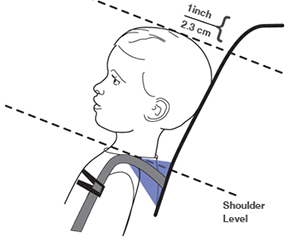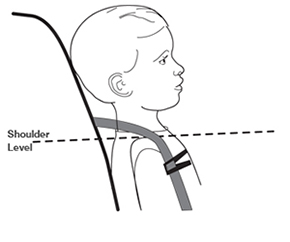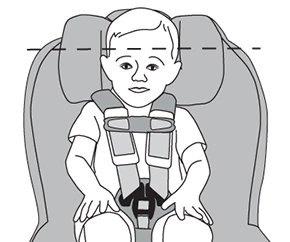How to Tell When Your Child Has Outgrown a Car Seat

For the best protection in case of a crash, children should ride in a car seat that fits them correctly. Since children come in all shapes and sizes and grow at different rates, there are a few different ways that they can outgrow a car seat first. Keep an eye on the measurements below – once your child exceeds the maximum capacity of their car seat in just one of these categories, they have outgrown their seat.
Weight
All car seats have a minimum and maximum weight capacity, and some seats have a different weight capacity for each mode of use. For example, a convertible car seat has a rear-facing weight capacity and forward-facing weight capacity.
How to Check:
Checking to see if your child has outgrown their car seat by weight is simple – just weigh your child and then refer to the labels on the side of the car seat or the user guide for the weight capacity.
Standing Height
All car seats also have a maximum height capacity that may be different for each mode of use. You should be able to find this information on the labels on the side of the seat or in your user guide.
How to Check:
If your child’s standing height exceeds the height limit, they have outgrown the seat.
Seated Shoulder Height
Since children’s torso lengths can vary significantly, even for children who are the same height, many children outgrow a car seat by seated shoulder height before reaching the maximum height capacity of the seat. For more information about seated shoulder height, visit our More to Measure page.
How to Check:
The instructions below apply to Britax car seats; for non-Britax car seats, refer to your user guide for instructions on how to determine if your child has outgrown the seat by seated shoulder height.
Rear-facing in a Britax Infant Car Seat: Your child has outgrown the seat in rear-facing mode if the top of their head is less than 1 inch below the top of the car seat shell when seated OR if the harness straps can’t be positioned in the closest position at or below their shoulders.

Rear-facing in a Britax Convertible Car Seat: Your child has outgrown the seat in rear-facing mode if the top of their head is less than 1 inch below the top of the car seat shell or head restraint, depending on the model, when seated OR if the harness straps can’t be positioned in the closest position at or below their shoulders.

Forward-facing in a Britax Convertible Car Seat: Your child has outgrown the seat if the tops of their ears are at or above the top of the car seat shell or head restraint, depending on the model, OR if the harness straps can’t be positioned in the closest position at or above their shoulders.

Forward-facing in a Britax Harness-2-Booster or Booster Seat: Your child has outgrown the seat if the tops of their ears are at or above the top of the head restraint when seated OR if the harness straps can’t be positioned in the closest position at or above their shoulders.
Age
Despite popular belief, children can’t outgrow a car seat by age. In fact, it’s best for children to remain in a rear-facing car seat for as long as possible, until at least 2 years of age or until reaching the maximum height, weight, or seated shoulder height capacity of the seat. It’s also safest for children to continue using a car seat with a five-point harness for as long as possible, so please don’t be in a hurry to transition your child to a belt-positioning booster seat. For instructions on how to tell when your child is ready for a booster seat, visit our Booster Basics page.